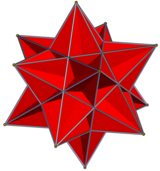Deltahedron


In geometry, a deltahedron (plural deltahedra) is a polyhedron whose faces are all equilateral triangles. The name is taken from the Greek upper case delta (Δ), which has the shape of an equilateral triangle. There are infinitely many deltahedra, all having an even number of faces by the handshaking lemma. Of these only eight are convex, having 4, 6, 8, 10, 12, 14, 16 and 20 faces.[1] The number of faces, edges, and vertices is listed below for each of the eight convex deltahedra.
The eight convex deltahedra[]
There are only eight strictly-convex deltahedra: three are regular polyhedra, and five are Johnson solids. The three regular convex polyhedra are indeed Platonic solids.
| Regular deltahedra | ||||||
|---|---|---|---|---|---|---|
| Image | Name | Faces | Edges | Vertices | Vertex configurations | Symmetry group |
 |
tetrahedron | 4 | 6 | 4 | 4 × 33 | Td, [3,3] |
 |
octahedron | 8 | 12 | 6 | 6 × 34 | Oh, [4,3] |
 |
icosahedron | 20 | 30 | 12 | 12 × 35 | Ih, [5,3] |
| Johnson deltahedra | ||||||
| Image | Name | Faces | Edges | Vertices | Vertex configurations | Symmetry group |
 |
triangular bipyramid | 6 | 9 | 5 | 2 × 33 3 × 34 |
D3h, [3,2] |
 |
pentagonal bipyramid | 10 | 15 | 7 | 5 × 34 2 × 35 |
D5h, [5,2] |
 |
snub disphenoid | 12 | 18 | 8 | 4 × 34 4 × 35 |
D2d, [2,2] |
 |
triaugmented triangular prism | 14 | 21 | 9 | 3 × 34 6 × 35 |
D3h, [3,2] |
 |
gyroelongated square bipyramid | 16 | 24 | 10 | 2 × 34 8 × 35 |
D4d, [4,2] |
In the 6-faced deltahedron, some vertices have degree 3 and some degree 4. In the 10-, 12-, 14-, and 16-faced deltahedra, some vertices have degree 4 and some degree 5. These five irregular deltahedra belong to the class of Johnson solids: convex polyhedra with regular polygons for faces.
Deltahedra retain their shape even if the edges are free to rotate around their vertices so that the angles between edges are fluid. Not all polyhedra have this property: for example, if you relax some of the angles of a cube, the cube can be deformed into a non-right square prism.
There is no 18-faced convex deltahedron.[2] However, the edge-contracted icosahedron gives an example of an octadecahedron that can either be made convex with 18 irregular triangular faces, or made with equilateral triangles that include two coplanar sets of three triangles.
Non-strictly convex cases[]
There are infinitely many cases with coplanar triangles, allowing for sections of the infinite triangular tilings. If the sets of coplanar triangles are considered a single face, a smaller set of faces, edges, and vertices can be counted. The coplanar triangular faces can be merged into rhombic, trapezoidal, hexagonal, or other equilateral polygon faces. Each face must be a convex polyiamond such as ![]() ,
, ![]() ,
, ![]() ,
, ![]() ,
, ![]() ,
, ![]() ,
, ![]() and
and ![]() , ...[3]
, ...[3]
Some smaller examples include:
| Image | Name | Faces | Edges | Vertices | Vertex configurations | Symmetry group |
|---|---|---|---|---|---|---|

|
Augmented octahedron Augmentation 1 tet + 1 oct |
10 |
15 | 7 | 1 × 33 3 × 34 3 × 35 0 × 36 |
C3v, [3] |
| 4 3 |
12 | |||||

|
Trigonal trapezohedron Augmentation 2 tets + 1 oct |
12 |
18 | 8 | 2 × 33 0 × 34 6 × 35 0 × 36 |
C3v, [3] |
| 6 |
12 | |||||

|
Augmentation 2 tets + 1 oct |
12 |
18 | 8 | 2 × 33 1 × 34 4 × 35 1 × 36 |
C2v, [2] |
| 2 2 2 |
11 | 7 | ||||

|
Triangular frustum Augmentation 3 tets + 1 oct |
14 |
21 | 9 | 3 × 33 0 × 34 3 × 35 3 × 36 |
C3v, [3] |
| 1 3 1 |
9 | 6 | ||||

|
Elongated octahedron Augmentation 2 tets + 2 octs |
16 |
24 | 10 | 0 × 33 4 × 34 4 × 35 2 × 36 |
D2h, [2,2] |
| 4 4 |
12 | 6 | ||||

|
Tetrahedron Augmentation 4 tets + 1 oct |
16 |
24 | 10 | 4 × 33 0 × 34 0 × 35 6 × 36 |
Td, [3,3] |
| 4 |
6 | 4 | ||||

|
Augmentation 3 tets + 2 octs |
18 |
27 | 11 | 1 × 33 2 × 34 5 × 35 3 × 36 |
D2h, [2,2] |
| 2 1 2 2 |
14 | 9 | ||||

|
Edge-contracted icosahedron | 18 |
27 | 11 | 0 × 33 2 × 34 8 × 35 1 × 36 |
C2v, [2] |
| 12 2 |
22 | 10 | ||||

|
Triangular bifrustum Augmentation 6 tets + 2 octs |
20 |
30 | 12 | 0 × 33 3 × 34 6 × 35 3 × 36 |
D3h, [3,2] |
| 2 6 |
15 | 9 | ||||

|
triangular cupola Augmentation 4 tets + 3 octs |
22 |
33 | 13 | 0 × 33 3 × 34 6 × 35 4 × 36 |
C3v, [3] |
| 3 3 1 1 |
15 | 9 | ||||

|
Triangular bipyramid Augmentation 8 tets + 2 octs |
24 |
36 | 14 | 2 × 33 3 × 34 0 × 35 9 × 36 |
D3h, [3] |
| 6 |
9 | 5 | ||||

|
Hexagonal antiprism | 24 |
36 | 14 | 0 × 33 0 × 34 12 × 35 2 × 36 |
D6d, [12,2+] |
| 12 2 |
24 | 12 | ||||

|
Truncated tetrahedron Augmentation 6 tets + 4 octs |
28 |
42 | 16 | 0 × 33 0 × 34 12 × 35 4 × 36 |
Td, [3,3] |
| 4 4 |
18 | 12 | ||||

|
Tetrakis cuboctahedron Octahedron Augmentation 8 tets + 6 octs |
32 |
48 | 18 | 0 × 33 12 × 34 0 × 35 6 × 36 |
Oh, [4,3] |
| 8 |
12 | 6 |
Non-convex forms[]
There are an infinite number of nonconvex forms.
Some examples of face-intersecting deltahedra:
- Great icosahedron - a Kepler-Poinsot solid, with 20 intersecting triangles
Other nonconvex deltahedra can be generated by adding equilateral pyramids to the faces of all 5 Platonic solids:

|

|
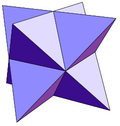
|
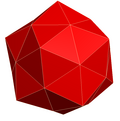
|
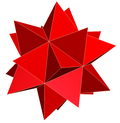
|
| triakis tetrahedron | tetrakis hexahedron | triakis octahedron (stella octangula) |
pentakis dodecahedron | triakis icosahedron |
|---|---|---|---|---|
| 12 triangles | 24 triangles | 60 triangles | ||
Other augmentations of the tetrahedron include:

|
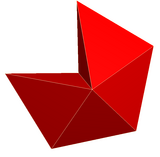
|
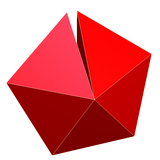
|
| 8 triangles | 10 triangles | 12 triangles |
|---|
Also by adding inverted pyramids to faces:
 Excavated dodecahedron |
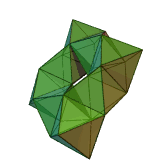 A toroidal deltahedron |
| 60 triangles | 48 triangles |
|---|
See also[]
- Simplicial polytope - polytopes with all simplex facets
References[]
- ^ Freudenthal, H; van der Waerden, B. L. (1947), "Over een bewering van Euclides ("On an Assertion of Euclid")", Simon Stevin (in Dutch), 25: 115–128 (They showed that there are just 8 convex deltahedra. )
- ^ Trigg, Charles W. (1978), "An Infinite Class of Deltahedra", Mathematics Magazine, 51 (1): 55–57, doi:10.1080/0025570X.1978.11976675, JSTOR 2689647.
- ^ The Convex Deltahedra And the Allowance of Coplanar Faces
Further reading[]
- Rausenberger, O. (1915), "Konvexe pseudoreguläre Polyeder", Zeitschrift für mathematischen und naturwissenschaftlichen Unterricht, 46: 135–142.
- Cundy, H. Martyn (December 1952), "Deltahedra", Mathematical Gazette, 36: 263–266, doi:10.2307/3608204, JSTOR 3608204.
- Cundy, H. Martyn; Rollett, A. (1989), "3.11. Deltahedra", Mathematical Models (3rd ed.), Stradbroke, England: Tarquin Pub., pp. 142–144.
- Gardner, Martin (1992), Fractal Music, Hypercards, and More: Mathematical Recreations from Scientific American, New York: W. H. Freeman, pp. 40, 53, and 58-60.
- Pugh, Anthony (1976), Polyhedra: A visual approach, California: University of California Press Berkeley, ISBN 0-520-03056-7 pp. 35–36
External links[]
- Deltahedra
- Polyhedra
